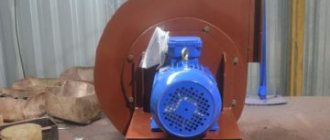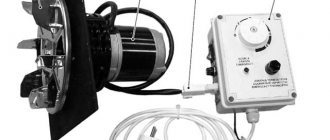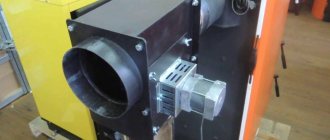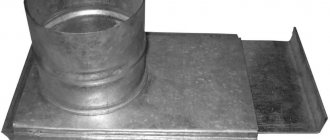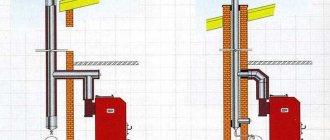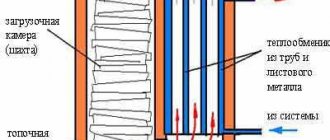Of all types of heating installations operating on solid fuel, the most effective are those in which pyrolysis occurs when burning wood or coal. This is the process of afterburning gases released from firewood or coal during their smoldering, which allows almost all the energy of fuel combustion to be transferred to the coolant. This principle uses a pyrolysis boiler circuit, in which the separation of combustible gas from fuel and its subsequent combustion is realized.
How to install a smoke exhauster
If you need to install a smoke exhauster on a chimney, which is impossible to remove or disassemble, and it is not possible to install the pump inside the room, then you have to install it outside. Although the best option for an electric motor is indoor installation. Smoke exhausters are usually sold with an impeller, an impeller and an electric motor with mounting for the boiler or for the pipe. You need to choose a suitable smoke exhauster, taking into account:
- Dimensions;
- Power;
- Connection diagram.
When there is a smoke exhauster and a chimney pipe, you need to figure out how to connect it all together. Most often, the engine is attached to an improvised snail. And the snail is welded (attached) directly to the chimney pipe. The connection slot must be equipped with a flap so that it can be opened or closed. Based on specific weather and other conditions - using natural or forced draft.
In principle, there is nothing complicated or supernatural about installing this device, and any home craftsman can handle it. Everything can be done with an ordinary grinder and drill at home. It is advisable to first make a connection drawing, which will indicate the dimensions and diameters of the nozzles and the main pipe. For example, if your chimney pipe is 159 mm, then the outlet from it for the smoke exhauster can be 110 mm in diameter.
Good draft is the result of correct calculation and installation of the chimney
When asked which chimney is better for a coal boiler, and which for a diesel boiler, etc., the correct answer will always be different. Because a chimney made for a wood-burning stove may be completely unsuitable for a gas boiler, for example. And there may be several reasons for this. At the same time, few people are able to install a new capital chimney to replace an ineffective one. That is why existing chimney pipes have to be improved in one way or another. Often, an improvement involves installing a smoke exhauster for a new domestic boiler.
Everywhere the chimney for a solid fuel boiler is made of solid brick. If it has sufficient height and cross-section, then it always has excellent traction and no air movement amplifiers are required. But there are also exceptions. For example, a brick chimney for a stationary solid fuel boiler cannot be brought to the required height. As a rule, a chimney for a solid fuel boiler is simply made by hand, but it does not always cope with its function perfectly. And it often happens that additional draft needs to be provided using smoke exhausters for household solid fuel boilers, purchased or made by yourself.
What and how to lay out a chimney so that it effectively copes with smoke removal is the topic of a separate large article, and now we will not touch on it. A solid brick chimney is good for a solid fuel boiler or stove, but without additional inserts it cannot be used for modern boilers using other types of fuel. For example, a smoke exhauster for a boiler may be needed if the chimney installation was done incorrectly from the very beginning.
How to properly make a connection to the chimney for a conventional solid fuel boiler? Highly qualified specialists know about this, but they are also mistaken, not noticing some local detail in time. A good smoke exhauster for a solid fuel boiler or any other can eliminate all errors in the design and construction of boilers and chimneys. Especially if the chimney for the boiler is not brick, but metal.
This is a whole science - installing a chimney for a solid fuel boiler. What can we say about more complex options for heating devices. Therefore, errors occur quite often; even simple brick laying is rarely ideal. Compliance with all technical standards for aerodynamics is another task! How to make a chimney if a brick boiler is connected to it? Will your own chimney for a solid fuel boiler be efficient enough? Such questions often cannot be answered in advance.
When is it necessary to increase the performance of a chimney?
Poor draft is not always the only reason for chimney work. It may be necessary to increase the rate of carbon monoxide removal if additional equipment is connected to the hood from the stove.
It is allowed to use a chimney to connect a column if the equipment is located on the same floor. And if the chimney has a sufficient smoke removal volume for operating the gas heater.
Another reason to increase the draft in the chimney is to install a more powerful heater. The required parameters of the chimney are indicated in the product data sheet.
It is also worth paying attention to how quickly you can light a fire in the stove. For example, if the draft is weak, damp wood will not burn
If the volumes of gases removed do not match the capabilities of the existing system, then the chimney needs to be modernized.
What is better: a smoke exhauster or a blower?
When the traction turbine is integrated into the heat generator by the manufacturer, such questions do not arise. Adding an exhaust fan to a conventional direct combustion boiler is another matter. You must understand that in this case the smoke exhauster solves only one problem - creating a vacuum in the firebox and increasing draft. There are a number of negative points here:
- Without an electronic control unit, performance will have to be adjusted manually. Automatic maintenance of coolant temperature is excluded.
- When air is supplied through the open ash chamber door, the fan will force the boiler to operate at maximum. Setting up a long burn mode will not be easy.
- In the event of an emergency stop of the impeller, fuel combustion will not stop, since gases pass freely through the volute or the body of the smoke exhauster. Air enters the firebox, increasing the likelihood of overheating.
- The impeller and internal surfaces of the unit become covered with soot, which must be removed. The rate of sticking depends on the moisture content and resin content of the wood.
Blowing machines always work in conjunction with a controller, so the problems listed above do not exist:
- the blower changes performance and turns off at the command of the control unit, the coolant heats up to the set temperature;
- during the combustion process, the ash pan door is hermetically closed, air is supplied through a separate channel;
- when there is a power outage, the air channel is automatically closed by a gravity damper;
- the impeller blades do not come into contact with hot smoke and soot.
Now let’s compare the cost of a traction fan and a blower fan, not taking into account the price of the controller. A smoke exhauster for a TT boiler up to 30 kW will cost 90 USD. e., supercharger - 60-65 cu. e. The difference is due to the design features of the exhaust unit - hot gases should not overheat the electric motor, plus the impeller is made of metal (when pressurized, it is made of plastic).
The installation complexity of the units is approximately the same. Installation of the discharge volute involves cutting out an opening in the ash pan door, and the smoke exhauster involves disassembling or cutting out the pipe. It is easier to install a roof hood, but you will have to pull a long cable.
Fan for solid fuel boiler
According to parameters and functional characteristics, fans for solid fuel boilers are divided into the following types:
- devices with electrically commutated motors (EC);
- fans equipped with synchronous motors;
- blowers with asynchronous motor.
Each type has its own advantages and disadvantages:
- Electrically commutated motor. This device is capable of independently changing the speed, having previously received the corresponding signal from the control unit, and also has a wide range of adjustment of the fan operation. However, the device also has a number of disadvantages - it is not compatible with most temperature controllers produced by domestic manufacturers, and besides, this equipment has a high price.
- Fan with synchronous motor. The device is easy to manufacture and has a low price. But this type of fan also has a number of disadvantages. For example, a small adjustment range and minimal torque during start-up.
- An asynchronous electric motor has many advantages. First of all, it is simple and easy to use. Secondly, it has a reliable design. However, there is also a drawback - high inrush currents.
To remove smoke, smoke exhausters are used, which you can read about on this page.
Device
Any blower fan, regardless of what country it is manufactured in, consists of a metal casing, and inside it there is an electric motor
Another important part of the blower fan are the blades, which are protected by a safety grille. The structure of the device is not complicated, but at the same time reliable
This is ensured by its robust housing, high operating temperature and reliable electric motor manufacturer. Vulnerable elements and parts are protected by a grille. The blower fan is lightweight, so installation problems do not arise.
Fan for solid fuel boiler
On the Russian market you can find fans for solid fuel boilers from the following manufacturers:
- Injection centrifugal fan (turbine) WPA of various modifications. Manufacturer: Polish company MplusM. This company specializes in the production of turbines for solid fuel boilers. The model is in stable demand on the Russian market, as it is characterized by high quality and good reliability.
- NWS fan of various modifications. Manufactured by Nowosolar (Poland). Its purpose is to pump air into the combustion chamber. This increases the efficiency of fuel combustion in the combustion chamber.
https://youtube.com/watch?v=8ZVXK4JcCNQ
How to choose the right one
The performance of a solid fuel boiler is largely determined by a properly selected fan. What does this mean?
Let's consider several situations:
- If a fan is installed that supplies less of the required air, the fuel will not burn completely. As a result, the boiler power decreases and the rated temperature is not reached.
- If a fan is installed that supplies a larger volume of the required air, then the solid fuel boiler will quickly gain temperature, and the fan will constantly turn on and off. As a result, fan failure is inevitable, the chimney will be constantly hot, and heat will escape through it.
There is only one way out - choose the right blower fan.
The table shows options for installed fans on solid fuel boilers of various capacities.
| WPA X2 | 285 | 62 | 32 |
| WPA 07 | 160 | 35 | 18 |
| WPA 06 | 255 | 55 | 28 |
| WPA 117 | 180 | 39 | 20 |
| WPA 120 | 285 | 62 | 32 |
| WPA 140 | 395 | 86 | 44 |
| WPA 145 | 505 | 110 | 56 |
| WPA 160 | 600 | 130 | 67 |
| NWS 75 | 205 | 45 | 23 |
| NWS 79 | 205 | 45 | 23 |
| NWS 100 | 240 | 52 | 27 |
Metal Fach spare parts
| Auger Metal Fach | from 20,000 rub. |
| Metal Fach controller | from 32,500 rub. |
| Display Metal Fach | from 9,155 rub. |
| Sensor Metal Fach | from 2,300 rub. |
| Thermostat | from 2,300 rub. |
| Fan Metal Fach | from 5,100 rub. |
| Burner Metal Fach | from 201,000 rub. |
| Auto-ignition Metal Fach | from 5,455 rub. |
| Relay Metal Fach | from 800 rub. |
| Geared motor Metal Fach | from 21,500 rub. |
Device Application
It is important to synchronize the operation of the boiler and fan during operation. Installing a smoke exhauster on a boiler without a control and automation unit is excluded, so you will have to buy and install all the electronics entirely anew
Such fans are indispensable when the following situations arise:
- heavy smoke in the room due to opening the firebox door, which may be facilitated by the design of the boiler;
- holes and cracks form in the brick chimney, so smoke is sucked through them;
- problems with draft - complex chimney design, strong winds and other problems;
- insufficient chimney height.
How to install a smoke exhauster
Increasing draft using a smoke exhauster also has a downside. If, after operating the fan for a certain time, the natural pressure does not increase, then you cannot turn off the smoke exhauster, since a possible consequence may be carbon monoxide suffocation. If the electricity goes out at night, smoke will enter the room, and this cannot be avoided. While the chain thermostat closes the damper, the entire boiler room will be in smoke
In this regard, it is very important to do good natural traction to avoid such cases.
Sources
- https://teplofan.ru/sistemy-otopleniya/komplektuyushhie/ventilyator-kotla
- https://RSVgroup.ru/ventilyatsiya/dutevoj-ventilyator-dlya-kotla.html
- https://oventilyacii.ru/kondicionirovanie/kak-sdelat-dymosos.html
- https://svoimi-rykami.ru/stroitelstvo-doma/pechi_i_mangaly/ventilyator-dlya-kotla-svoimi-rukami.html
- https://klimatlab.com/otoplenie/tverdtoplivo/dymosos-dlya-tverdotoplivnogo-kotla-svoimi-rukami.html
Device
The smoke exhauster is a simple device in terms of design. It consists of several nodes, each of which has its own purpose.
- Frame.
- Suction pipe or suction pocket of the smoke exhauster.
- Guide apparatus. There is right and left rotation, which is determined by the direction of the fan blades.
- Working wheel.
- Frame.
- Electric motor.
The body is made in the form of a “snail”, which provides the required swirl of air entering the unit. Made of heat-resistant steel, covered with thermal insulation.
The guide apparatus of the smoke exhauster is located on the suction pipe and allows air pressure to be regulated using a rotating mechanism that combines the fan blades. Each blade is curved, which allows the air flow to rotate in the same direction in which the rotor rotates. Using a rotating mechanism, you can block the lumen of the pipe to one degree or another.
The smoke exhauster impeller is the unit on which the fan blades are located. They are attached to it by welding or rivets. A rarefied atmosphere is created in the central part of the wheel as it rotates. For this reason, incoming air is drawn in here. Small-sized devices such as smoke exhausters for fireplaces work in a similar way.
The wheel docking unit can be located on the motor shaft or intermediate shaft, depending on the design of the unit. If this is dust collection equipment, the device includes special filters with absorbents. All fire-fighting units are equipped in this way. Ash collectors can be included in the design of boiler room equipment. The design of the smoke exhauster determines its purpose.
The impeller may have holes necessary to fix the blades in a given position. Balancing can be done manually or by an electrical actuator. You can distinguish the direction of rotation of the fan blades if you look at the unit from the side of its electric motor. The axial guide apparatus of the smoke exhauster ensures rotation of the blades, regardless of their number and direction of slope, at an angle from 0 to 90°.
A blower fan and a smoke exhauster have a similar design, but differ in purpose. Devices of the first type provide air injection into the boiler furnace. The latter are designed to remove fuel combustion products and release them into the atmosphere outside the boiler room.
Fans and smoke exhausters of boiler installations have the same operating principle; they can be left- or right-handed, with forward and reverse draft. These machines are designed for long-term trouble-free operation in a temperature range from 0 °C to +250 °C. Smoke exhausters are marked as “D” and “DN”, fans - as “VDN”. The latter are produced with the impeller mounted on the electric motor shaft.
Repair of smoke exhausters and fans is carried out by persons who have undergone appropriate certification and instruction in the safety precautions for operating electrical appliances.
Inlet valve for increased draft
Without air entering the room or directly into the stove, the chimney will not work. Vents or cracks in old windows are not the best method for air flow.
The disadvantages are obvious:
- Cold air enters the room through the cracks even when the stove or fireplace is not working.
- In winter, air from the street constantly changes the indoor environment. At the same time, the relative humidity of the air drops sharply, which has a harmful effect on health. A person's mucous membranes dry out, creating conditions for colds.
- The window must be opened and closed manually.
It is much more effective to provide air flow using a valve. It closes automatically when furnace equipment or gas heaters are not operating.
This is what a wall supply valve looks like, which is installed in rooms with stove heating or gas equipment to improve air flow
Heaters require a boiler room valve to operate. The device has different characteristics than similar operating principles for room ventilation.
The supply valve is placed diagonally or above the heated surface so that the cold air rises to the ceiling. But it is best if oxygen is supplied directly to the firebox. At the same time, the humidity and temperature conditions in the room are not disturbed.
What is a fireplace exhauster and why is it needed?
This device is a duct fan with an electric motor, which is mounted at the outlet of the chimney. The principle of operation of the device is simple - during operation of the fan, the draft in the chimney increases.
Simply put, this device is a forced exhaust system, but they are not designed for full exhaust. They are used only to improve (occasionally) the natural draft in the pipe, or during its repair.
Chimney hoods
For example, a fireplace smoke exhauster is started as needed - for a time when the natural draft drops to a certain value.
When should it be used?
There are several indications for the use of a fireplace smoke exhauster, which are in one way or another related to draft disturbances in the chimney pipe.
Indications for use:
- When there is no draft at all in the chimney pipe (for example, due to errors in the construction of the chimney pipe, or because of its weakness in terms of exhaust). This often happens when the chimney height is selected incorrectly.
- In cases where the chimney is incorrectly positioned relative to the roof ridge.
- If a taller building was built nearby and, accordingly, the draft fell because of this (due to an obstruction to wind flows).
- In cases where the chimney needs repair work (gaps, cracks, or any protruding elements have appeared).
- In cases where the diameter of the chimney chosen is not large enough, or, on the contrary, too large.
Pros and cons of use
Any device of this type has both a number of undeniable advantages and a number of disadvantages. This is also true for smoke exhausters.
Among the advantages of such a device it is worth noting:
- you don’t have to repair the chimney “right now” - the smoke exhauster allows you to postpone repair work indefinitely;
- the ability to create the necessary traction by increasing it, in any weather;
- you can significantly reduce the harm from the formation of condensation due to the fact that the draft will be increased, and as a result, less condensate will form;
- the ability to turn off the fan at any time when there is sufficient natural exhaust from the chimney.
List of disadvantages of using such a device:
- It is not always possible to install a smoke exhauster;
- additional consumption of electrical energy (however, to be fair, such fans consume relatively little electricity).
For which chimneys is it suitable?
The smoke exhauster can be used on chimney pipes for stoves, fireplaces, and various boilers (gas and solid fuel)
But there is one important condition - such a product can only be installed on chimneys in which the temperature does not exceed +600 degrees
Types of fastening of chimney hoods
This also applies to heat-resistant models. Although they are designed for high-temperature operation, they are not too high (therefore they are used for a stove or fireplace, but not for industrial purposes). Moreover, +600 degrees is a very good indicator; many heat-resistant smoke exhausters are even designed for temperatures up to +350 degrees (average value).
Forced exhaust by additional means
The need to install additional means of forced exhaust may arise for natural reasons, for example, trees have grown on the site, which has changed the direction or intensity of wind flows.
Watch the video
We increase chimney draft artificially
You can, of course, rebuild the house or redo the chimneys, but this path is very expensive and labor-intensive. It is easier and cheaper to use forced ventilation devices. To improve the hood, the following additional devices are used.
Purpose and device
Blower fans are installed at the end points of chimneys and facilitate the removal of combustion products by creating a strong vacuum that draws smoke and other gases from the firebox system and chimney. The operating conditions of the smoke exhauster are characterized by high temperature loads; contact with combustion products contributes to rapid wear and metal fatigue. The design of the smoke exhauster must correspond to the load level and ensure efficient operation throughout its service life.
The structure includes:
- heat-resistant fan (made of stainless, alloy or, less commonly, carbon steel)
- a guide device installed on the suction side and organizing the correct flow direction
- suction funnel connecting the guide vane to the fan inlet
- electric motor
The body of the smoke exhauster, regardless of the material of manufacture, is covered with a protective polymer coating. It increases the service life of parts and helps reduce thermal corrosion of materials. The direction of inclination of the impeller blades is used both forward and reverse. The first option is most often used on small boilers with relatively mild operating conditions, the second option is used on powerful installations with high temperatures of exhaust gases.
For use as smoke exhausters, not only radial, but also axial devices can be used. There are flow-through structures that are located at the outlet of the boiler. They are not completely located in the channel, but only a part of the impeller that increases thrust. Such designs are not full-fledged smoke exhausters, but they are quite effective as draft amplifiers. The best option is to install a specialized centrifugal type device that gives maximum effect.
Preventing the condition of the chimney
To avoid the need to use means of forced exhaust of a chimney made of heat-resistant material, it is necessary to use preventive means to maintain it in working condition.
Since the main reason for reducing the intensity of flue gas extraction is the reduction in the passage of the pipe by soot accumulated on the walls, we will consider means of combating this phenomenon.
These methods could be:
- Burning about half a tablespoon of naphthalene in the furnace firebox. Naphthalene vapor decomposes soot into loose components, large ones fall inside the firebox and are subsequently removed with the ash, and small ones fly out through the pipe along with the furnace gases. This product cannot be used for smoke removal from a fireplace and for pipes of open hearths - it leaves a characteristic suffocating smell in the rooms.
- From time to time, burn potato peelings in the firebox. They are pre-dried. Starch vapors loosen the soot deposit and it will fall into the firebox. Pure starch acts similarly, which is fed into a well-lit firebox in the amount of one tablespoon.
- A good way to remove soot from pipes is walnut shells. It burns at a high temperature, burning off soot deposits on the inner walls. A single dose of shells should be no more than three liters. Frequency of application - as accumulation occurs.
- Aspen firewood has a similar effect on soot. One or two logs are burned at the end of the last stack of firewood. They burn at high temperatures.
The frequency of use of high-temperature products should be regular, at least twice a week, so that soot does not have time to accumulate.
Otherwise, you can cause a serious fire, since the soot burns and releases a very large amount of heat. In addition to those listed, there are many anti-soot agents on the market for both chemical and thermal decomposition of soot. The use of preventive measures can eliminate the need for forced measures to improve the exhaust hood on the chimney.
Homemade designs
You can make smoke exhausters for boilers with your own hands. This will save you money on buying a factory hood. To fold such a machine yourself, you only need to purchase an electric motor. The remaining components can be made from available materials.
Hood from scrap materials
The set of tools required for work consists of:
- Bulgarians;
- welding machine;
- drills;
- metalworking tools;
- hammer;
- rulers;
- caliper.
Work begins with the manufacture of an exhaust fan. The impeller, matched to the size of the exhaust pipe, is secured to the motor shaft. The engine, using fasteners equipped on its body, is placed in the pipe.
After connecting the motor to the wiring, during the first test run it is necessary to check the direction of the air flow and, if necessary, adjust the operation of the rotor.
The pipe for placing the turbine is selected with a diameter 2-3 cm wider. Its length should extend beyond the fan by 3-5 mm. One end of the pipe is welded with a lid, a hole is made in the center for the chimney, and another one is equipped on the side, to which the outlet pipe is attached.
During operation, the fan should not cause increased vibration of the hood body. To prevent this from happening, it is installed using bushings to center the bearings.
The hood assembly is completed by welding the back cover to the pipe and attaching the motor to the stand. After connecting the air ducts and electrical wiring to the unit, it is ready for use.
Intermediate option
This option for assembling a drawing machine does not require special alignment of the impeller, which is a rather delicate and complex job for a non-professional. A factory-assembled mechanism is usually already centered and only requires checking during trial operation.
Sources
- https://teplo.guru/kotly/tverdotoplivnye/dyimosos.html
- https://aquagroup.ru/articles/dymososy-dlya-kotlov.html
- https://kaminguru.com/dymohod/dymosos-dlja-kotla.html
- https://trubanet.ru/truby-dlya-otopleniya/prinuditelnaia-vytiazhka-dlia-dymohoda.html
- https://teplospec.com/tverdotoplivnoe-otoplenie/kak-vybrat-dymosos-dlya-tverdotoplivnogo-kotla-vidy-razlichiya.html
- https://otivent.com/dymosos-dlja-tverdotoplivnogo-kotla
- https://1poclimaty.ru/montazh/dymosos-svoimi-rukami.html
- https://klimatlab.com/otoplenie/tverdtoplivo/dymosos-dlya-tverdotoplivnogo-kotla-svoimi-rukami.html
- https://teplofan.ru/sistemy-otopleniya/komplektuyushhie/dymosos
